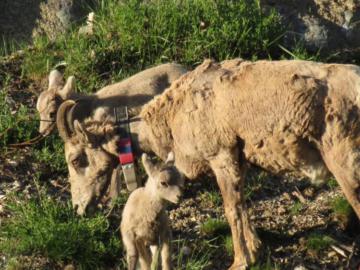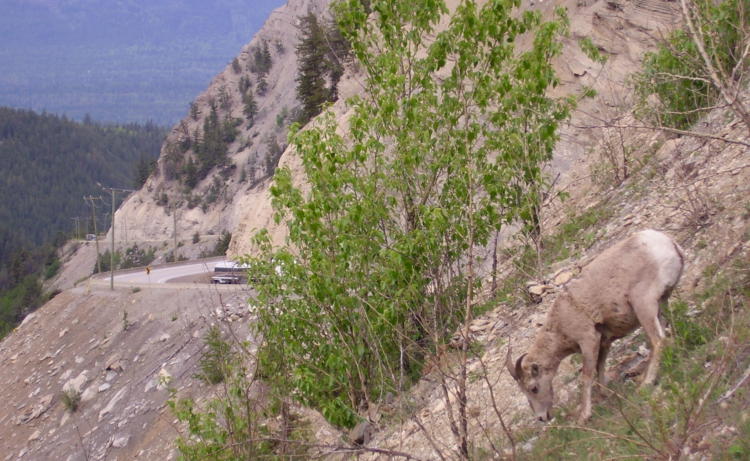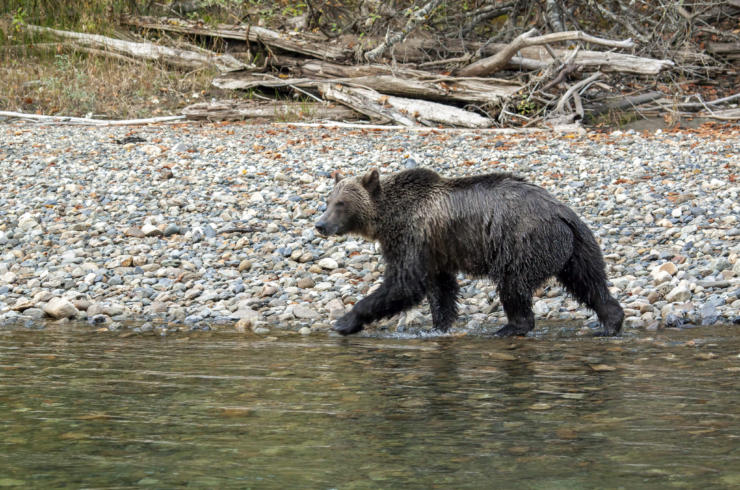As you drive west on the Trans-Canda Highway, passing from Alberta’s rolling fields and into the Rockies, the Trans-Canada Highway squeezes itself into a narrow passageway known as the Kicking Horse Canyon. Here, the wide highway compresses into a thin concrete line that cuts into canyon walls; steep cliff sides drop to the Kicking Horse River below while jagged, avalanche-prone walls rise up the other side, a testament to the engineering feat of this stretch of road.
If you travel this corridor, you may be lucky enough to spot a Rocky Mountain bighorn sheep. A herd of about 14 sheep live in this narrow corridor and can be found roaming back and forth, drawn to the roadside for its vegetation, minerals, and perhaps easy passage and reprieve from some predators.

Drivers coming out of the windy, narrow canyon will find themselves in the town of Golden, where Meg Langley lives. A retired teacher and wildlife biologist with an MSc. in Wildlife Biology, Meg became interested in the local bighorn sheep herd and began to travel into the canyon to study them about five years ago.
With more than 12,000 vehicles travelling this corridor daily in peak summer months, the two lane highway was not enough to contain the volume of traffic. So the Kicking Horse Canyon has gone through a series of construction projects to expand its capacity and safety. It is currently undergoing the final, and largest, project.
Knowing that the largest scale project was coming, Meg wanted to learn about this fairly visible herd and investigate what might be limiting their numbers. To study the sheep, she would regularly travel the highway out to the Yoho bridge (about 7 km outside of Golden) to observe the herd, record their location, group composition and behavior. She uses noninvasive methods to study wildlife whenever possible, and brought that research strategy to this project
But, how do you study a wildlife species using noninvasive methods?
“Poop,” states Meg. “It’s amazing how much you can learn from poop.”
From genetic variability, parasites and diet to stress levels and pregnancies in the animals, fecal matter contains a wealth of information. Collecting and sending samples has proved a unique challenge for the citizen scientist though. For example, at certain times of the year, bighorn sheep droppings look very much like white tailed deer droppings, meaning Meg needs to actually catch them in the act to collect the correct samples (which may require following them up steep slopes, down into canyons, or just hanging out watching the herd graze alongside the highway).
Then there’s the lab work. Not every lab will do every type of analysis, and they require different methods of preservation of the samples. Kicking Horse Canyon herd samples have been mailed to the Toronto Zoo, the University of Alberta, a lab in Nelson and even into Washington State.
Meg did the research on her own for several years. Then in 2019 she partnered with Wildsight Golden to continue her research, ultimately producing a 71-page report documenting the case study and recommendations for herd viability.
Findings:
Overall, this herd is not in a good position to thrive, Meg’s findings show. Despite their relatively high genetic diversity, their diet quality is poor, there is a limited amount of suitable habitat, and their mortality rate is high due to the busy highway slicing through their home.
One of the surprising findings from the research was the bighorn sheep’s thwarting of wildlife fencing in the canyon. Protecting wildlife from fast-moving vehicles, and vehicles from unpredictable wildlife, has long been a struggle for road managers. Fencing has been installed in a short section of the canyon to help solve this problem. But if an animal happens to get on the wrong side of the divide, they can get stuck pinballing their way down the highway in an effort to get out. So one-way fences and jump outs are installed to allow animals to get off of the road.
Meg has witnessed repeatedly that this herd of bighorn sheep has managed not only to jump the wrong way up the escape jump-outs through a supposed one-way fence, but have actually come through the gates the ‘wrong’ way too, either opening one side of the gate with their horns or squeezing in between the J-shaped tines.
After video evidence of this happening was sent to the Ministry of Transportation and Infrastructure (MOTI), 12 cameras were installed to monitor the frequency of this behavior.
“Since then, we’ve documented hundreds of cases of bighorn sheep getting through the gates, and jumping up the jump-outs,” Meg says.

Next steps:
An interesting collaboration also came out of this research. Meg and Wildsight Golden invited 14 artists to paint a portrait of each of the 14 bighorn sheep living in the canyon last year. The exhibit, Vanishing Bighorns, will be on display in the Art Gallery of Golden this February; Meg hopes the show will inspire and create awareness for these resident ungulates.
Meg recently had the opportunity to present her findings at the 22nd Northern Wild Goat and Sheep Council Biennial Symposium and she has offered her support to the MOTI-employed biologists involved in the Kicking Horse Canyon project.
Meg plans to continue studying the sheep’s stress hormones and gathering information about the fencing impacts as the Kicking Horse Canyon construction project continues, and hopes to do what she can to protect this bighorn sheep herd from further decimation.
To learn more, visit the project page.


Reconnecting the Rockies








